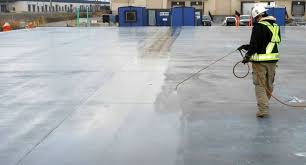Curing concrete is something you can do as part of a DIY project. You can certainly do it at home, and some people master it with little difficulty. However, you can always hire someone to handle this part of a job if you feel like you’re not up to it.
Poured concrete is something you need to handle with care, which is why so many homeowners opt to hire a professional rather than do it themselves. If you’re going to try curing concrete on your own, though, you should know about some of the dos and don’ts associated with it. We will discuss a couple of both right now.
Cover Your New Concrete
Part of curing newly poured concrete involves revisiting it with a hose several times. However, you may not always have the chance to do this.
Another option is to cover up the newly poured concrete with a tarp. This can trap and slow down the moisture in the mix as it gradually evaporates.
If you do this, use something like polyethylene sheeting. A concrete curing insulating blanket is also a viable option.
Spray Water on the New Concrete
What is even better is if you can spray water on the newly poured concrete as it dries. This effectively cures it. You will want to do this about 5-10 times during the first few hours after you pour the fresh concrete.
The pros call this moist curing. If you use this method, the final product will be a lot stronger than it would be otherwise. Concrete that you helped cure with water should last much longer without cracking.
Don’t Pour if It’s Too Cold
Pouring new concrete when the weather is too cold is one of the most common mistakes DIY concrete pourers make. You should wait till a time of the year when the temperatures will stay over 50 degrees for the next 5-7 days. That could be in the late spring, summer, or early fall, depending on the part of the country in which you live.
If the temperature drops unexpectedly after you have poured your new concrete, though, don’t despair. You can counteract some of the effects by putting a concrete insulating blanket over it. You can even use some old household blankets if necessary.
Don’t Forget the Control Joints
You should put control joints in your concrete slab as you pour it. You can cut these a quarter of the depth of the slab as you begin the curing process. You will want to do it within 24 hours of the initial pour.
If you’re not sure how to do this, watch some helpful videos. There are plenty of them online. Doing this will strengthen the finished product. You should end up with a concrete foundation that won’t crack for years.
Pouring and curing concrete may seem daunting at first, but many DIY endeavors that involve it are within your power as a homeowner. Remember these tips as you move forward with your project.


